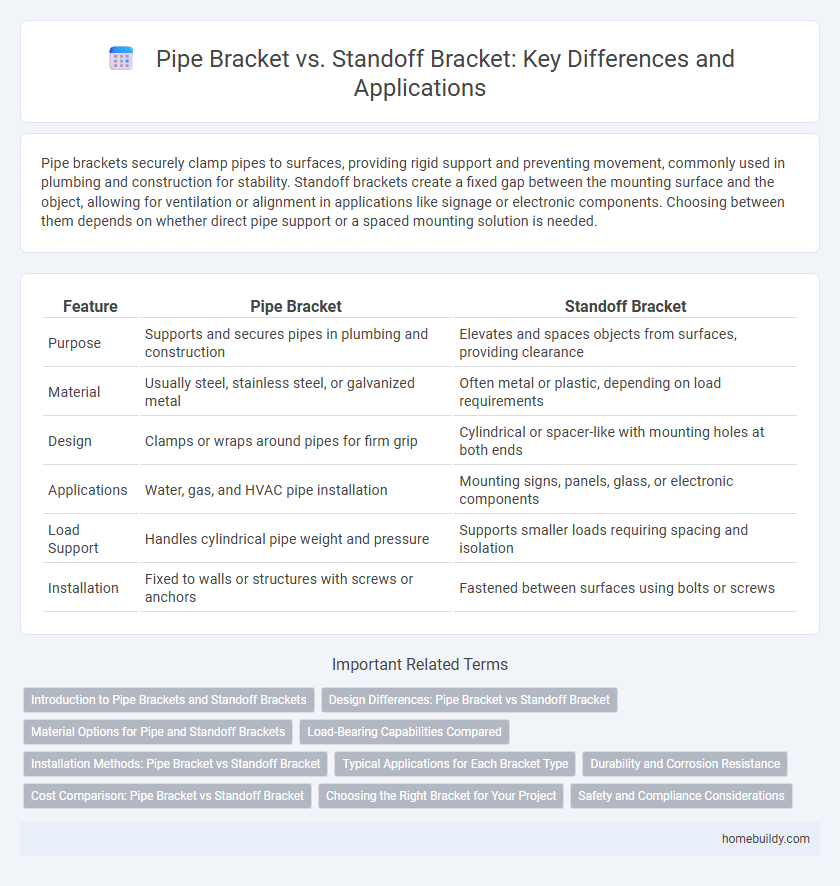Pipe brackets securely clamp pipes to surfaces, providing rigid support and preventing movement, commonly used in plumbing and construction for stability. Standoff brackets create a fixed gap between the mounting surface and the object, allowing for ventilation or alignment in applications like signage or electronic components. Choosing between them depends on whether direct pipe support or a spaced mounting solution is needed.
Table of Comparison
| Feature | Pipe Bracket | Standoff Bracket |
|---|---|---|
| Purpose | Supports and secures pipes in plumbing and construction | Elevates and spaces objects from surfaces, providing clearance |
| Material | Usually steel, stainless steel, or galvanized metal | Often metal or plastic, depending on load requirements |
| Design | Clamps or wraps around pipes for firm grip | Cylindrical or spacer-like with mounting holes at both ends |
| Applications | Water, gas, and HVAC pipe installation | Mounting signs, panels, glass, or electronic components |
| Load Support | Handles cylindrical pipe weight and pressure | Supports smaller loads requiring spacing and isolation |
| Installation | Fixed to walls or structures with screws or anchors | Fastened between surfaces using bolts or screws |
Introduction to Pipe Brackets and Standoff Brackets
Pipe brackets are essential hardware components designed to securely support and stabilize pipes in various plumbing and industrial applications, ensuring proper alignment and load distribution. Standoff brackets, by contrast, provide a fixed distance between a pipe or structural element and the mounting surface, facilitating insulation, clearance, and maintenance access. Understanding the distinct functions of pipe brackets and standoff brackets is crucial for selecting the appropriate support system based on installation requirements and pipe specifications.
Design Differences: Pipe Bracket vs Standoff Bracket
Pipe brackets are designed to support and secure pipes by providing a direct clamping mechanism that closely follows the pipe's contour, ensuring stability in plumbing and mechanical installations. Standoff brackets feature elevated mounting points that create a gap between the mounted object and the surface, offering space for airflow, insulation, or clearance for wiring. The key design difference lies in the pipe bracket's emphasis on tight, supportive contact with cylindrical surfaces, while standoff brackets prioritize separation and elevation from the mounting plane.
Material Options for Pipe and Standoff Brackets
Pipe brackets are commonly made from durable materials such as stainless steel, galvanized steel, and aluminum, offering excellent corrosion resistance and strength for supporting heavy pipe loads. Standoff brackets often utilize similar materials but may also include reinforced plastics or composite materials to provide lightweight yet sturdy support with insulation properties. Material selection for both pipe and standoff brackets depends on environmental conditions, load requirements, and application-specific factors to ensure longevity and performance.
Load-Bearing Capabilities Compared
Pipe brackets provide robust load-bearing capabilities designed to securely support heavy pipe installations, distributing weight evenly to minimize stress on mounting surfaces. Standoff brackets offer moderate load support, primarily used to maintain a fixed distance between the pipe and the mounting surface, but typically bear less weight than pipe brackets. For heavy-duty applications requiring maximal load distribution and stability, pipe brackets are generally superior to standoff brackets.
Installation Methods: Pipe Bracket vs Standoff Bracket
Pipe brackets are typically installed by clamping or bolting directly onto pipes or structural surfaces, ensuring secure support for piping systems with minimal space requirements. Standoff brackets, however, require a mounting surface and create a gap between the surface and the attached pipe or component, often installed using anchors or screws to provide clearance for insulation or maintenance access. Installation methods for pipe brackets prioritize direct attachment and stability, while standoff brackets focus on spacing and accessibility.
Typical Applications for Each Bracket Type
Pipe brackets are commonly used to secure pipes in plumbing, HVAC, and industrial piping systems, providing strong support against vibrations and environmental stress. Standoff brackets are typically employed to mount electrical panels, signage, or equipment at a set distance from surfaces, ensuring ventilation and easy access for maintenance. The choice between pipe and standoff brackets depends on load requirements and the need for spacing between mounted objects and surfaces.
Durability and Corrosion Resistance
Pipe brackets exhibit superior durability and corrosion resistance compared to standoff brackets due to their robust material composition, often featuring galvanized steel or stainless steel alloys designed to withstand harsh environmental conditions. The design of pipe brackets allows for better load distribution and mechanical stability, minimizing wear and extending service life in industrial and plumbing applications. In contrast, standoff brackets, typically made from lighter materials, may suffer from quicker degradation when exposed to moisture and corrosive elements, making pipe brackets the preferred choice for long-term reliability.
Cost Comparison: Pipe Bracket vs Standoff Bracket
Pipe brackets typically cost less than standoff brackets due to simpler design and manufacturing processes. Standoff brackets require more material and precision machining, increasing their price and installation complexity. Choosing pipe brackets can result in significant savings for projects with large-scale piping systems without sacrificing basic support functionality.
Choosing the Right Bracket for Your Project
Pipe brackets provide robust support for securing pipes directly to surfaces, ensuring stability in plumbing and construction applications, while standoff brackets elevate components away from walls or panels, allowing space for insulation or airflow. Choosing the right bracket depends on the specific project requirements such as load capacity, environmental conditions, and spatial constraints. Consider pipe diameter, bracket material (steel, stainless steel, or aluminum), and mounting surface to optimize durability and function.
Safety and Compliance Considerations
Pipe brackets provide superior safety by securely supporting pipes, preventing movement that could lead to leaks or structural damage, essential for compliance with industry standards such as ASME B31.3. In contrast, standoff brackets, while useful for spacing, may not offer the same level of stability required for high-pressure or hazardous pipe systems, potentially risking non-compliance with safety regulations like OSHA guidelines. Selecting pipe brackets aligned with regulatory codes enhances system integrity and ensures adherence to safety protocols in industrial and commercial installations.
pipe bracket vs standoff bracket Infographic

 homebuildy.com
homebuildy.com